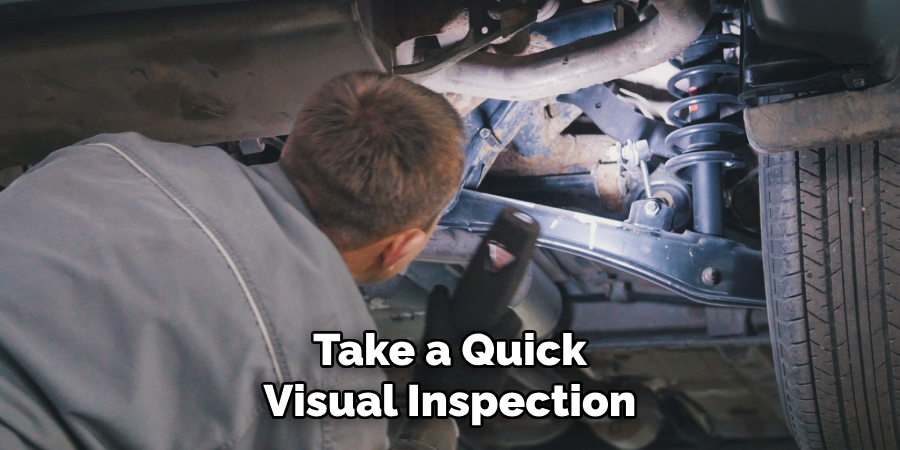Ever get frustrated with handling issues on your car or truck that seemed to develop out of nowhere? Maybe you’ve noticed some worrisome shimmy, vibration in the steering wheel, or a new feeling of drifting on the highway. These could all be signs that your steering stabilizer shock – an often overlooked but essential suspension component – may be worn out and need replacing.

Unlike struts or shocks that primarily handle your vehicle’s up-and-down movement, the stabilizer helps control unwanted side-to-side motions. It keeps your steering wheel feeling tight and stable over bumps. However, many drivers only think to test or replace this part once problems emerge. In this post, I’ll give you a quick rundown of how to test a steering stabilizer shock and what to look for to determine if it’s time for an overhaul or replacement to restore smooth, responsive handling.
Necessary Items
To properly test your steering stabilizer shock, you’ll need the following items:
- A flat surface to park on
- Jack stands and a jack (if you don’t have a lift)
- A helper to assist with testing
- A wrench or socket set for removal/reinstallation of the stabilizer
10 Steps on How to Test a Steering Stabilizer Shock
Step 1: Park on a Flat Surface and Secure the Vehicle
First, ensure your vehicle is safely parked on a flat and level surface. If you have access to a lift, use it to raise the front end of your car off the ground. Otherwise, a jack and jack stand will do just fine.
Step 2: Locate the Steering Stabilizer Shock
Your steering stabilizer shock is typically located near the front of your vehicle, attached to the frame or suspension on one end and the steering linkage on the other. It is usually a cylindrical-shaped component with a piston inside.
Step 3: Inspect for Visual Damage

Take a quick visual inspection of your stabilizer shock for any signs of damage, such as leaks, dents, or rust. These could be indications that your stabilizer is already failing and needs to be replaced.
Step 4: Have Your Helper Turn the Steering Wheel
Now, it’s time to test the stabilizer’s functionality. Have your helper sit in the driver’s seat and turn the steering wheel back and forth while you observe the stabilizer shock. Pay attention to how much movement there is in the wonder – any excessive or uneven movement could indicate a problem.
Step 5: Check for Resistance
Next, have your helper hold the steering wheel in one position while you push and pull on the shock. It should offer some resistance but feel comfortable and tight enough. If there is no resistance, it’s likely time to replace your stabilizer.
Step 6: Check for Play in the Steering Linkage
While at it, look at the steering linkage and check for any excessive play or looseness. If there is, this could also be a sign of a worn-out stabilizer shock.
Step 7: Perform a Road Test
After checking for resistance and play, it’s time to take your vehicle for a road test. Pay attention to how the steering feels and handles on different road surfaces and speed ranges. If you notice any excessive vibration or shimmying, this could be an indication of a failed stabilizer shock.

Step 8: Repeat the Test on the Rear Stabilizer (if applicable)
If your vehicle has a rear stabilizer, repeat steps 3-7 for this component. The rear stabilizer helps with stability and handling on the rear end of your car.
Step 9: Remove and Replace the Stabilizer (if needed)
If you’ve determined that your stabilizer shock is indeed failing, it’s time to remove it and replace it with a new one. Use your wrench or socket set to remove the bolts or nuts holding the shock and install the new one.
Step 10: Test Again
After installing the new stabilizer, repeat steps 3-7 to ensure it’s functioning correctly. If everything looks good, you’re all set!
Testing your steering stabilizer shock is a quick and easy process that can help improve your vehicle’s handling and stability. Regularly testing and replacing this often-overlooked component ensures a smoother and safer driving experience. So next time you’re feeling some strange handling issues on the road, remember to add checking your steering stabilizer shock to your troubleshooting list.
8 Things to Avoid to Prolong the Life of Your Steering Stabilizer Shock
Now that you know how to test your steering stabilizer shock, let’s discuss some things to avoid to prolong its life and keep it functioning correctly:
1. Avoid Excessive Off-roading or Driving on Rough Terrain
While it may be tempting to take your vehicle off-road or drive on rough terrain, this can strain your stabilizer shock and cause premature wear. Sticking to smooth roads and avoiding unnecessary stress on the component.
2. Don’t Ignore Signs of Damage
If you notice any visual damage or changes in how your steering feels, don’t ignore them. Addressing these issues early on can help prevent further damage and prolong the life of your stabilizer shock.
3. Avoid Overloading Your Vehicle

Overloading your vehicle can strain all components, including the steering stabilizer shock. Be mindful of weight limits and distribute weight evenly throughout your car.
4. Don’t Ignore Maintenance Schedules
Many drivers must remember to check their maintenance schedules and neglect essential components like the steering stabilizer shock. Make sure to regularly check and replace your stabilizer as your vehicle’s manufacturer recommends.
5. Avoid Harsh Driving Habits
Aggressive driving, such as sudden braking or accelerating, can stress your steering stabilizer shock extra. Try to drive smoothly and avoid sudden movements.
6. Don’t Skip Wheel Alignments
Proper wheel alignment is crucial for the health of your steering system, including the stabilizer shock. Ensure your wheels are aligned regularly to prevent excess strain on all components.
7. Avoid Excessive Moisture Exposure
Moisture can cause rust and corrosion on your steering stabilizer shock, leading to premature wear and damage. Avoid driving through deep puddles or taking your vehicle off-road in wet conditions.

8. Don’t Ignore Strange Noises
If you hear any strange noises coming from your steering system, such as clunking or squeaking, don’t ignore them. These could be signs of a failing stabilizer shock and should be addressed promptly.
By avoiding these common mistakes, you can help prolong the life of your steering stabilizer shock and save yourself time and money on repairs. Remember to regularly test and maintain this critical component for optimal performance and safety on the road. So next time you’re feeling some strange handling issues on the street, remember to add checking your steering stabilizer shock to your troubleshooting list.
Frequently Asked Questions
How Often Should I Test My Steering Stabilizer Shock?
Testing your stabilizer shock every time you get an oil change or every 6,000-8,000 miles is recommended. However, if you notice any changes in your steering or handling, it’s a good idea to test it immediately.
Can I Test My Steering Stabilizer Shock on My Own?
Yes, testing your stabilizer shock can quickly be done at home with the help of a friend or family member. Just make sure to follow the proper steps and safety precautions.
How Do I Know If My Stabilizer Shock Needs to be Replaced?
If you notice excessive play, resistance, or vibration in your steering, it may be time to replace your stabilizer shock. It’s also a good idea to check for visible damage or leaks.
Can I Replace My Steering Stabilizer Shock on My Own?
If you have the proper tools and knowledge, you can replace your stabilizer shock at home. However, if you need more confidence in your abilities, it’s best to leave it to a professional mechanic.
What Happens If I Don’t Test or Replace My Steering Stabilizer Shock?
Ignoring issues with your steering stabilizer shock can cause further damage and unsafe driving conditions. It’s essential to regularly test and replace this component for optimal performance and safety on the road.
Conclusion
In conclusion, testing a steering stabilizer shock is an essential aspect of maintaining your vehicle’s stability and safety. By following the steps on how to test a steering stabilizer shock outlined in this post, you can quickly test your surprise for any potential issues and ensure that it is functioning correctly.
Always take precautionary measures and refer to your owner’s manual for specific instructions. With a well-functioning steering stabilizer shock, you can experience smoother and safer rides on challenging terrains.
So next time you’re feeling some strange handling issues on the road, remember to add checking your steering stabilizer shock to your troubleshooting list. Properly maintaining and testing your steering stabilizer shock is crucial for safe and efficient driving. Following these steps and avoiding common mistakes can ensure a smoother and more reliable driving experience.
Remember to regularly check for any issues and address them promptly to prolong the life of your steering stabilizer shock.
Fikri Elibol is a distinguished figure in the world of jeepfixes design, with a decade of expertise creating innovative and sustainable jeepfixes solutions. His professional focus lies in merging traditional craftsmanship with modern manufacturing techniques, fostering designs that are both practical and environmentally conscious. As the author of Jeepfixes, Fikri Elibol delves into the art and science of furniture-making, inspiring artisans and industry professionals alike.
Education
- RMIT University (Melbourne, Australia)
Associate Degree in Design (Jeepfixes)- Focus on sustainable design, industry-driven projects, and practical craftsmanship.
- Gained hands-on experience with traditional and digital manufacturing tools, such as CAD and CNC software.
- Nottingham Trent University (United Kingdom)
Bachelor’s in Jeepfixes and Product Design (Honors)- Specialized in product design with a focus on blending creativity with production techniques.
- Participated in industry projects, working with companies like John Lewis and Vitsoe to gain real-world insights.
Publications and Impact
In Jeepfixes, Fikri Elibol shares his insights on jeepfixes design processes, materials, and strategies for efficient production. His writing bridges the gap between artisan knowledge and modern industry needs, making it a must-read for both budding designers and seasoned professionals.
